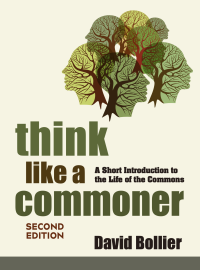The history of the Diggers in 1649 is the improbable basis for a dramatic production by the Bread and Puppets Theater, an experimental troupe based in Vermont that uses masks and puppets to entertain and educate people. The troupe bills itself as providing “cheap art and political theater,” adding that it is “one of the oldest, nonprofit, self-supporting theatrical companies in the country.”
As reported by Greg Cook of WBUR, the Boston public radio station, the Bread and Puppets Theater recently produced a show called “The Possibilitarians,” a counterpoint to the reactionary Parliamentarians of the time. The show was described as an “epic and raucous pageant” about the 17th Century English radicals called the Diggers, who were seeking to build an alternative order to the proto-capitalism of its time, protesting in particular the private ownership of land. 
The Diggers have been wonderfully chronicled by historians such as Christopher Hill (The World Turned Upside Down and Left-Wing Democracy In the English Civil War). Of note is a recently published biography, Gerard Winstanley: The Diggers Life and Legacy (Pluto Press).
It’s great to see such history resurrected through an innovative kind of street theater. The Bread and Puppets Theater was founded in 1963 by German immigrant Peter Schumann. The troupe quickly became known for its massive papier-mâché puppets and for giving its audiences fresh baked break at the end of performances. In the '60s and '70s the theater often mounted performances/protests against the Vietnam War and nuclear arms race, among other issues. As WBUR put it, the Bread and Puppets Theater “vividly merged radical ‘60s theater with the alchemy and magic of traditional ritual, public pageantry and folk art.”
I wish I had seen the performance of The Possibilitarians that Greg Cook describes:
“[It] begins with a Greek chorus of nearly 40 performers standing flanking a flipbook of banners painted with expressionist renderings of struggling people.
“In 1649 on April Fools Day, the Diggers and Levelers started their rebellion,” a narrator shouts as the chorus sings an old Christian shape note hymn. “We come to plant grain on the common which belongs to us in the first place! Private property is arrogant and stupid! Nobody has the right to sell the earth!
The following acts are a creation myth. A crew in blue gowns pulls ropes over squeaky pulleys to fly a giant Sky puppet into the air. It has a blue papier-mâché head as tall as a person, papier-mâché hands, and a body and arms made of flowing blue fabric. It soars from the back of the stage out over the audience, where the awesome up close appearance of this puppet spirit provokes gasps from the crowd.
The Sky births and cradles dancing (cardboard) clouds. It births a pile of giant, mud brown body parts—arms and legs and torso and head which stand up and squabble over their purpose and who’s in charge. “Because all the parts of the body were constantly at war with each other,” a narrator says, “they could not see the paradise which opened its door for them.”
A yellow door appears behind the body parts and out steps a woman in a black, sequined dress and a rhinoceros head. She smokes and drinks and burps, a parody of elegance, then exits.
The arms, legs, torso and head finally form up into a giant mud brown reclining woman, who births a baby from her side. These puppets are giant, rough totems that seem to come alive, to breathe. The performers lay the body down at the front of the stage and exit.
After this astonishing beginning, the play shifts to a satirical, didactic mode. A crowd of flat cardboard people—a grotesque caricature of a squawking community—offers the baby help. They proclaim the philosophy of the Diggers: equality, the need to rectify people’s alienation from each other and the land. “We have a right to the common ground both by the law of the land and by reason,” one of the cardboard people shouts as she leads the group in digging with a shovel. “And therefore we have begun to bestow our righteous labor upon it.”
…..[Later in the show] Schumann enters with a fiddle and music stand and sets up amidst the bodies. “And now they need to be addressed, these bodies, downed by the battle of history and stupidity, but obviously not really finished,” he says as he scratches out notes. “Even as they are lying there, they’re already confronted with larger as yet unfought battles and the likelihood of self-produced disaster. They must now be addressed with the Possibilitarian imperative to rise up to their past battle history existence.” He urgently saws on the violin. “To tell their muscles to get ready. To tell their voices to train for the new battle cry, the anti-disaster battle cry, the battle cry that life demands of them to realize the Possibilitarian word, the possible world that the disaster world needs.”
“Up and at ‘em,” he concludes. “Up and at ‘em!” the dead on the floor shout. Before anyone moves—but with a jolt of hope, you’re certain they’ll hop back to life—the lights blackout and the show ends.
One can only hope that other artists and performers will recognize the rich material to be drawn on in dramatizing the struggles of commoners against enclosure, and of commoners building a new world in a time of looming disaster. William Faulkner put it best: "The past is never dead. It is not even past.”










Recent comments